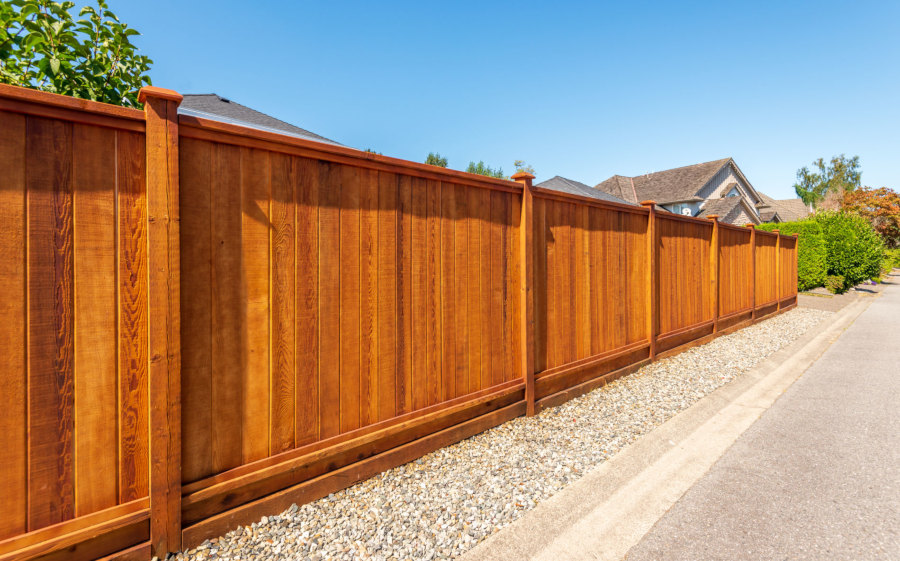Fence Staining 101: Every Little Thing You Required to Know for a Spectacular End Up
When it concerns enhancing the aesthetic charm and lengthening the life-span of your fence, staining is an important aspect that requires attention to information. The procedure of fencing discoloration involves more than just selecting a color and applying it haphazardly. From choosing the ideal kind of tarnish to diligently preparing the surface and performing the application technique, every step plays a considerable duty in achieving a flawless finish. By comprehending the basics of fence staining, you can raise the appearance of your outdoor space and make certain the defense of your fencing versus different aspects.
Selecting the Right Discoloration
Picking an ideal discolor for your fence is important in preserving its longevity and boosting its aesthetic appeal. When choosing the ideal discolor, there are several variables to think about. Firstly, determine the kind of wood your fencing is made from, as various wood species react in a different way to various discolorations. Cedar may call for a different kind of stain compared to ache. Next, take into consideration the preferred appearance you intend to attain. If you prefer an even more all-natural look that enables the timber grain to show with, a clear or semi-transparent stain would be appropriate. If you want to add shade or conceal imperfections in the wood, a strong tarnish could be the far better option. It is also necessary to consider the degree of maintenance you agree to devote to. Some stains might call for more frequent reapplication than others, so select a tarnish that straightens with your upkeep choices. By taking these elements into account, you can choose a tarnish that not just protects your fence yet likewise improves its overall appearance.
Preparing Your Fence
Prior to applying the chosen tarnish to your fencing, it is necessary to appropriately prepare the surface area to guarantee optimal outcomes and long life. The very first step in preparing your fencing is to cleanse it thoroughly.
Fining sand the fence is the following essential action to make certain a smooth surface for the tarnish to adhere to. Utilize a medium-grit sandpaper to eliminate any kind of rough areas or old tarnish that may be peeling off.
Finally, secure any locations you do not desire to tarnish by utilizing painter's tape and plastic sheeting - Fence Staining Service - Fence Staining. This will make sure tidy lines and avoid unintended staining of other surface areas. Properly preparing your fencing will not just improve the final look but also add to the long life of the stain

Applying the Spot
To accomplish a professional surface when staining your fencing, make sure that you apply the tarnish in even strokes complying with the wood grain direction. Prior to starting, drink or stir the stain extensively to mix any cleared up pigments. Utilizing a top quality brush or a paint sprayer, begin applying the tarnish from the top of the fence, functioning your way down to protect against drips.
If using several canisters of stain, mix them with each other to make certain color consistency. Fence Staining. Correct application is key to achieving a lovely and long-lasting finish on your fence - Fence Staining Service.
Tips for a Specialist Finish
Accomplishing an expert coating on your tarnished fencing requires meticulous attention to detail and adherence to finest methods in application strategies. To make certain a spectacular result, begin by completely preparing the fence surface area. Tidy the fence of any type of dust, particles, or old discolor utilizing a stress washing machine or a rigid brush and soapy water. Let the fence dry totally before continuing with the discoloration procedure. Select a high-quality stain that appropriates for your fencing kind and environment problems. Before applying the tarnish, protect bordering locations with plastic sheet or decrease fabrics to stop unintentional spills or splatters.
When it comes to applying the tarnish, utilize a brush, roller, or sprayer for an also and consistent layer. Allow the discolor to completely dry totally according to the supplier's directions prior to considering directory a 2nd layer.
Maintenance and Care
Making certain regular maintenance and proper care of your discolored fencing is essential for preserving its appearance and architectural honesty with time. To maintain the spectacular surface attained with staining, it is suggested to check the fencing a minimum of annually for any kind of indicators of wear, damages, or staining. Addressing issues quickly can prevent them from escalating and requiring much more considerable repairs.
Regular upkeep jobs consist of cleaning up the fencing with a moderate detergent and water to remove dirt, grime, and mold that can gather with time. In addition, cutting any type of greenery that enters call with the fencing can avoid damage from overgrowth. Inspect the stain for indicators of fading or putting on away, and think about applying a maintenance layer every 2-3 years to maintain the fence looking fresh and vibrant.
Correct treatment likewise involves protecting the discolored fence from rough elements by considering factors such as sun exposure, dampness, and temperature level variations - Fence Staining Service. Applying a safety sealant can further boost the durability of the stain and secure the timber from ecological damage. By following these upkeep methods, you can ensure that your tarnished fence continues to be an attractive and long lasting asset to your residential or commercial property for years to find
Conclusion
